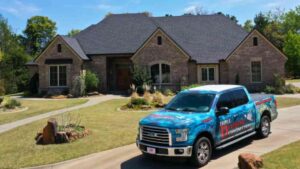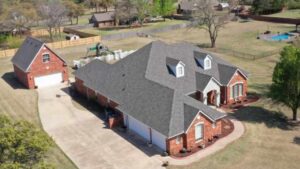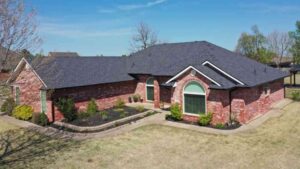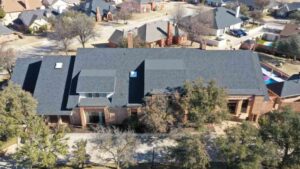A roof is one of the most important components of your home, protecting it from the elements and keeping you safe and comfortable. However, severe weather events, such as hailstorms, can significantly impact a roofs lifespan and lead to costly repairs. If your home recently endured a hailstorm, you might be wondering: How does hail damage affect my roof’s lifespan? Do I need a repair, or is it time for a complete replacement?
In this blog, we’ll explore how hail can shorten your roofs lifespan, what factors influence whether repairs or replacements are necessary, and how you can maintain and extend your roof’s remaining lifespan after a hailstorm.
How Hail Damage Affects a Roof’s Lifespan
Even though your roof is designed to withstand various weather conditions, hail can cause extensive damage that accelerates its aging process. The impact of hailstones can compromise the integrity of your roof’s shingles, causing them to lose granules, crack, or even develop punctures. These issues can shorten your roof’s lifespan in several ways:
Granule Loss and UV Exposure
Asphalt shingles are coated with granules that protect them from UV rays and add a layer of fire resistance. When hailstones hit the roof, they can knock these granules loose, leaving the asphalt exposed. Over time, this exposure to sunlight causes the shingles to dry out, become brittle, and deteriorate more quickly. Granule loss can also lead to uneven wear, making the roof more susceptible to leaks.
Bruising and Cracking
The force of hailstones can create bruises or soft spots on shingles that are difficult to see from the ground. These bruises weaken the shingle’s structure, making it more prone to cracking under extreme temperatures or additional impacts. Cracked shingles can lead to water penetration and rot, both of which significantly reduce the roof’s lifespan.
Weakened Underlayment and Roof Deck
If hail punctures or tears through shingles, it can damage the underlayment and even the roof deck itself. When the underlayment is compromised, it can no longer provide an effective moisture barrier, leading to water leaks that can cause wood rot and mold growth in the roof deck. This type of damage often requires more than just shingle replacement—it may necessitate a full roof replacement to prevent further structural issues.
Damaged Flashing and Roof Components
Hail doesn’t just damage shingles—it can also dent metal flashing, vents, and other roof components. Damaged flashing can create openings for water to seep in around chimneys, skylights, and valleys. If these areas are not properly repaired, they can cause leaks and structural damage over time, shortening the overall lifespan of your roof.
Factors That Determine Whether You Need a Roof Repair or Replacement
After a hailstorm, the decision to repair or replace your roof depends on several factors, including:
- Extent of the Damage: Minor damage, such as a few cracked or missing shingles, can typically be repaired without compromising the roof’s overall performance. However, if the hail damage is widespread, with multiple soft spots, cracks, or missing shingles, a complete roof replacement may be necessary.
- Age of the Roof: The age of your roof plays a significant role in determining whether repairs are sufficient. A newer roof (less than 10 years old) that sustains damage may still have many years of life left after targeted repairs. On the other hand, an older roof (15+ years) that’s been damaged by hail may be nearing the end of its lifespan, making a replacement the better long-term investment.
- Type of Roofing Material: Different roofing materials react differently to hail. Asphalt shingles, metal roofs, and tile roofs all have varying levels of resistance to hail damage. Metal roofs, for example, may show visible dents but are less likely to suffer structural damage compared to asphalt shingles. Understanding your roof’s material and its typical response to hail is crucial in making a repair or replacement decision.
- Previous Damage or Repairs: If your roof has sustained damage from previous storms or has undergone multiple repairs, it may be more vulnerable to hail damage. In such cases, replacing the roof may be more cost-effective and provide better long-term protection.
- Insurance Coverage: Insurance policies often cover storm-related damage, including hail, but they may have limitations based on the age and condition of your roof. It’s essential to work with your insurance company to understand what’s covered and whether they recommend repairs or a full replacement.
Tips for Maintaining Roofs Lifespan After a Hailstorm
Whether you decide to repair or replace your roof after a hailstorm, maintaining it properly can help extend its remaining lifespan. Here are some tips to keep your roof in good shape:
Schedule Regular Inspections: Have your roof inspected by a professional at least once a year and after any significant weather events. Regular inspections help catch minor issues before they turn into major problems, saving you time and money in the long run.
Repair Damage Promptly: Call a roofing company ASAP to address any minor repairs as soon as they’re identified to prevent further damage. Even small cracks or loose shingles can let moisture in, leading to more extensive issues over time.
Clear Debris and Maintain Gutters: Keep your roof and gutters clear of debris, such as leaves, twigs, and dirt. Clogged gutters can cause water to back up onto the roof, leading to leaks and water damage.
Trim Overhanging Branches: Trees that hang over your roof can scratch shingles, drop debris, and create shaded areas that encourage moss growth. Keep branches trimmed back to reduce the risk of damage.
Consider Impact-Resistant Shingles: If you need a roof replacement, consider upgrading to impact-resistant shingles, which are designed to withstand hail and other severe weather conditions. This investment can increase your roof’s durability and potentially reduce your insurance premiums.
When to Call a Roofing Professional
If your home has been through a hailstorm and you’re unsure of your roof’s condition, it’s best to call a professional roofing contractor for a thorough inspection. A qualified contractor, like Triple Diamond Construction, can assess the damage, provide documentation for insurance purposes, and recommend the best course of action to protect your home.
At Triple Diamond Construction, we offer free, no-obligation inspections to help homeowners understand their roof’s condition and determine the best steps forward. Don’t wait until minor damage becomes a major issue—contact us today to schedule your inspection!
Call 405-895-9972 or visit https://triplediamondok.com/free-roof-inspection-okc/ to schedule a free roof inspection online.
By understanding how hail damage affects your roof’s lifespan and taking proactive measures, you can extend the life of your roof and protect your home from further damage!





